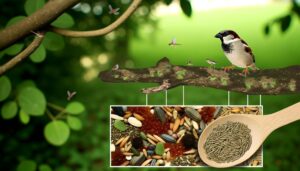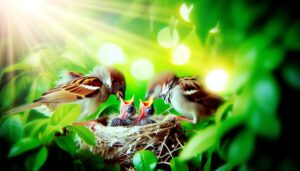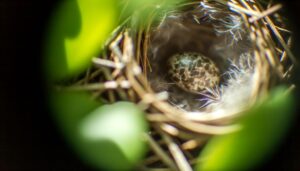Measuring Small Cape Sable Seaside Sparrow Eggs: A Guide
Cape Sable Seaside Sparrow eggs are relatively small, measuring around 1.7 cm in length and 1.3 cm in width. The average dimensions range from 18 to 20 mm in length and approximately 14 mm in diameter.
These eggs are delicately adapted to the species' specific ecological requirements, allowing for rapid embryonic development. Nesting behavior in dense grasslands involves constructing nests at the base of sawgrass clumps to avoid flooding.
The small egg size and unique nesting strategies are critical aspects for understanding the reproductive ecology of this endangered bird species. For more detailed observations and conservation strategies, further insights await.
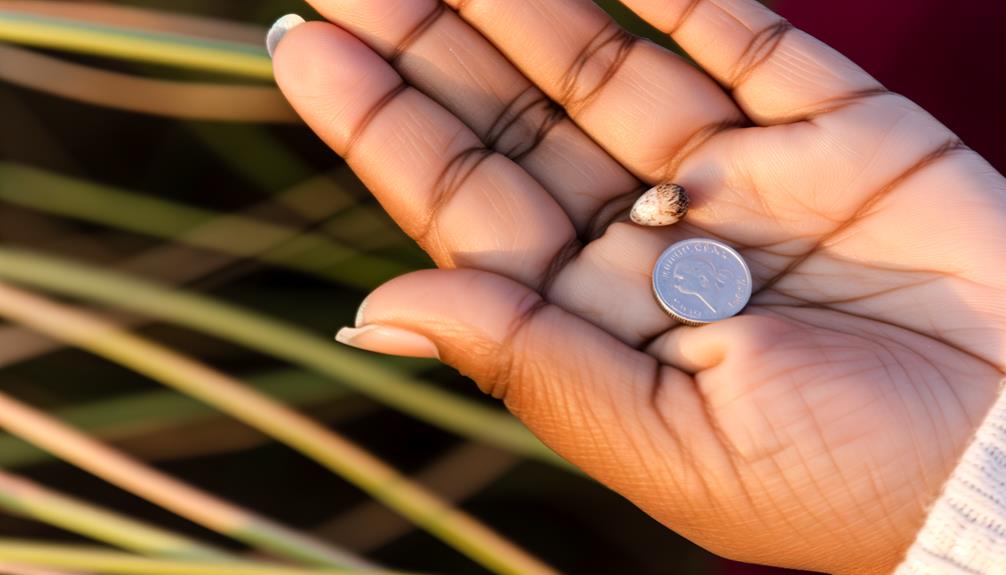
Key Takeaways
- Cape Sable Seaside Sparrow eggs measure approximately 1.7 cm in length and 1.3 cm in width.
- The average egg size ranges from 18 to 20 mm in length.
- Egg diameters typically measure around 14 mm.
- Small egg size may facilitate rapid embryonic development.
- Comparative analysis shows varied ecological adaptations among species.
Habitat and Distribution
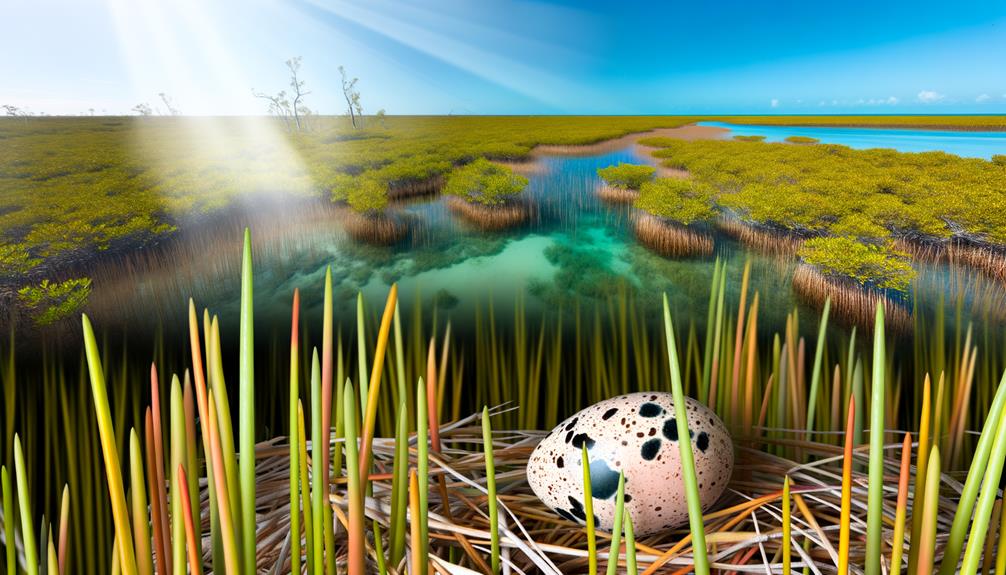
The Cape Sable seaside sparrow (Ammospiza maritima mirabilis) mainly inhabits the marl prairies of the Florida Everglades, a unique and delicate ecosystem characterized by seasonally inundated grasslands. These prairies consist mainly of sawgrass (Cladium jamaicense) interspersed with muhly grass (Muhlenbergia filipes) and other native flora.
The sparrow's distribution is highly localized, confined to the southernmost regions of Florida. This habitat specificity results in a fragmented population structure, with six known subpopulations. The hydrological regime of these prairies is essential; both prolonged flooding and excessive drying can disrupt nesting success, influencing population stability.
Given these strict habitat requirements, conservation efforts must prioritize maintaining the delicate balance of water levels within the Everglades to secure the species' survival.
Physical Characteristics
Understanding the habitat and distribution intricacies of the Cape Sable seaside sparrow provides important context for examining its physical characteristics, which include a small, slender body and distinct plumage patterns. Adult sparrows typically measure 13-14 cm in length with an approximate wingspan of 18 cm.
Their plumage exhibits a muted palette, featuring olive-gray upperparts and pale underparts adorned with fine streaks. Importantly, a distinguishing trait is the yellowish coloration near the lores and throat. The bill is relatively short and conical, adapted for their diet of insects and seeds. Sexual dimorphism is minimal, making field identification based on gender challenging.
Such detailed morphological parameters are essential for avian biologists studying the species' ecology and behavior.
Egg Dimensions
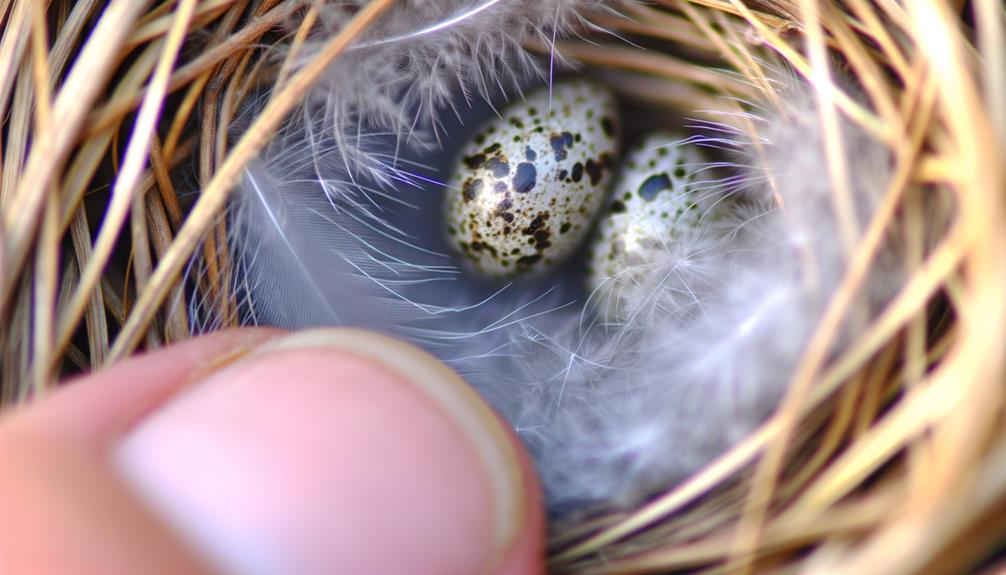
The average dimensions of Cape Sable Seaside Sparrow eggs are typically around 1.7 centimeters in length and 1.3 centimeters in width. These measurements were obtained through meticulous field studies involving the collection and examination of numerous egg samples.
Comparative analysis with eggs of other sparrow species reveals that Cape Sable Seaside Sparrow eggs are relatively smaller, highlighting unique adaptive characteristics.
Average Egg Size
Measuring the dimensions of Cape Sable Seaside Sparrow eggs reveals that they typically range from 18 to 20 millimeters in length and approximately 14 millimeters in diameter.
Detailed morphometric analysis indicates that these dimensions are consistent across multiple clutch samples. The average egg size is thus deduced by calculating the mean values from a substantial dataset, ensuring statistical accuracy.
This precise measurement is vital for understanding the reproductive ecology of the species. The uniformity in egg size also suggests a potential evolutionary adaptation to the sparrow's specific nesting environment.
Such methodical documentation aids in the conservation efforts by providing essential data on the reproductive health and viability of the Cape Sable Seaside Sparrow population.
Comparative Egg Analysis
Comparative analysis of avian egg dimensions reveals significant variations among species, providing insights into their reproductive strategies and ecological adaptations.
The Cape Sable Seaside Sparrow (Ammospiza maritima mirabilis) lays eggs measuring approximately 17-18 mm in length and 13-14 mm in width, which are relatively small compared to other passerine species.
For instance, the American Robin's (Turdus migratorius) eggs average around 30 mm in length and 21 mm in width. These dimensional differences are indicative of varied nest predation risks, habitat conditions, and parental investment.
Smaller eggs, such as those of the Cape Sable Seaside Sparrow, may facilitate rapid embryonic development, thereby reducing the period of vulnerability to predation. This precision in egg size underscores intricate ecological adaptations.
Nesting Habits
Utilizing intricate natural materials, Cape Sable seaside sparrows construct their nests in the dense grasslands of the Everglades, ensuring ideal protection and camouflage for their eggs.
These nests are mostly woven from grasses and sedges, meticulously placed at the base of sawgrass clumps or other sturdy vegetation.
The structure comprises an exterior layer of coarse grasses for stability and an interior lined with finer materials such as rootlets and feathers, providing a soft, insulated environment for the eggs.
Observations indicate that nest placement is strategic, often elevated slightly above ground to mitigate flooding risks while maintaining concealment from predators.
This nesting behavior demonstrates the species' adaptive strategies for enhancing reproductive success in their unique habitat.
Breeding Season
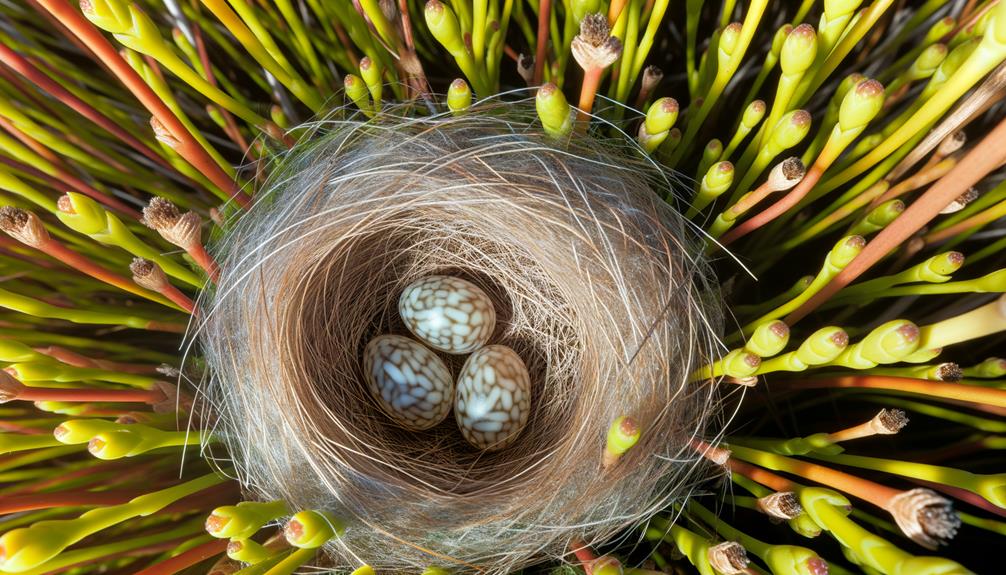
The breeding season for Cape Sable seaside sparrows typically begins in early March and extends through late July, marked by a series of courtship behaviors and nest-building activities. Males establish and defend territories through vocalizations, using a distinct song to attract females. At the same time, females select nesting sites within these territories, preferring elevated locations amidst dense vegetation to reduce flooding risks.
Courtship behaviors include synchronized flights and specific vocal exchanges. Upon pairing, both sexes engage in nest construction, using grasses and sedges to create cup-shaped nests. Observations indicate that ideal nesting conditions are essential for reproductive success, with habitat quality directly impacting clutch size and fledgling survival rates.
This period is important for species propagation and population stability.
Egg Development
Following the completion of nest construction, the female Cape Sable seaside sparrow typically lays a clutch of three to four eggs, initiating the critical phase of egg development. These eggs, remarkably small and elliptical, undergo an incubation period lasting approximately 12-14 days. During this time, the female maintains a consistent presence, applying precise thermoregulation to ensure ideal embryonic growth.
Embryogenesis proceeds through clearly defined stages, commencing with zygote cleavage and proceeding to organogenesis. Detailed observations reveal that the eggshell, composed primarily of calcium carbonate, provides necessary structural integrity while allowing gas exchange through microscopic pores. This meticulous process culminates in the hatching of altricial chicks, which emerge blind and featherless, necessitating immediate parental care for survival and growth.
Predators and Threats
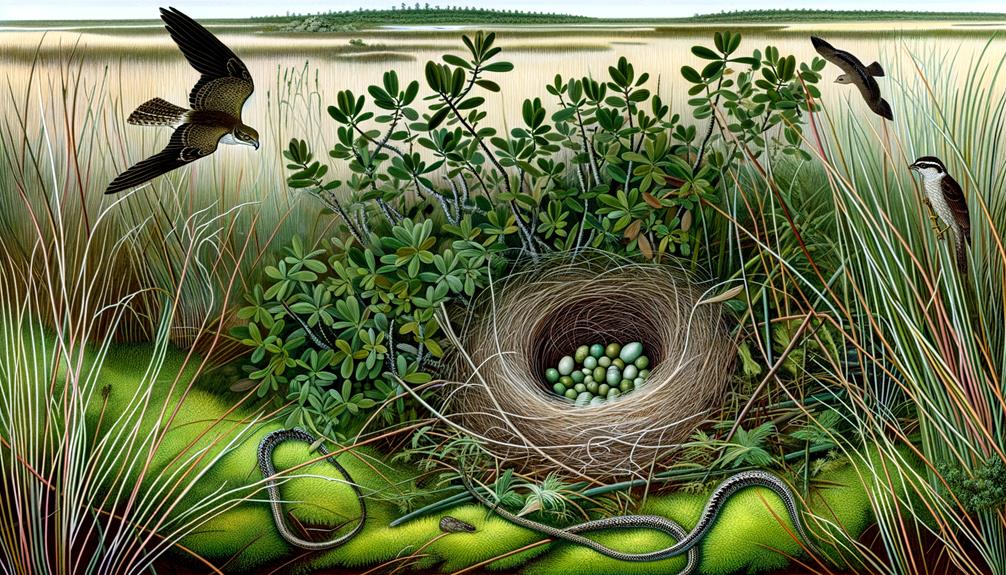
What factors contribute to the heightened vulnerability of Cape Sable seaside sparrow eggs to predation and environmental threats?
The diminutive size of the eggs renders them susceptible to a range of predators, including snakes, raccoons, and avian species.
Nesting in low-lying marshlands, these sparrows are also at risk from environmental hazards such as flooding, which can devastate entire clutches.
Habitat fragmentation exacerbates these threats by reducing available nesting sites and increasing edge effects, thereby facilitating predator access.
Additionally, human-induced changes in water management and land use disrupt the delicate hydrological balance critical for nesting success.
These combined pressures necessitate rigorous monitoring and protective measures to mitigate the adverse impacts on the Cape Sable seaside sparrow population.
Conservation Efforts
Implementing targeted conservation strategies is essential for enhancing the survival rates of Cape Sable seaside sparrow eggs and their overall population stability. These strategies involve meticulous habitat management, predator control, and monitoring programs.
Habitat restoration focuses on maintaining ideal water levels and vegetation structures. Predator control aims to mitigate the impact of invasive species. Long-term monitoring tracks population trends and reproductive success.
- Habitat loss due to human encroachment and water management practices
- Predation by introduced species, such as feral cats and raccoons
- Climate change affecting nesting sites and food availability
- Environmental degradation from pollution and habitat fragmentation
Ecological Importance
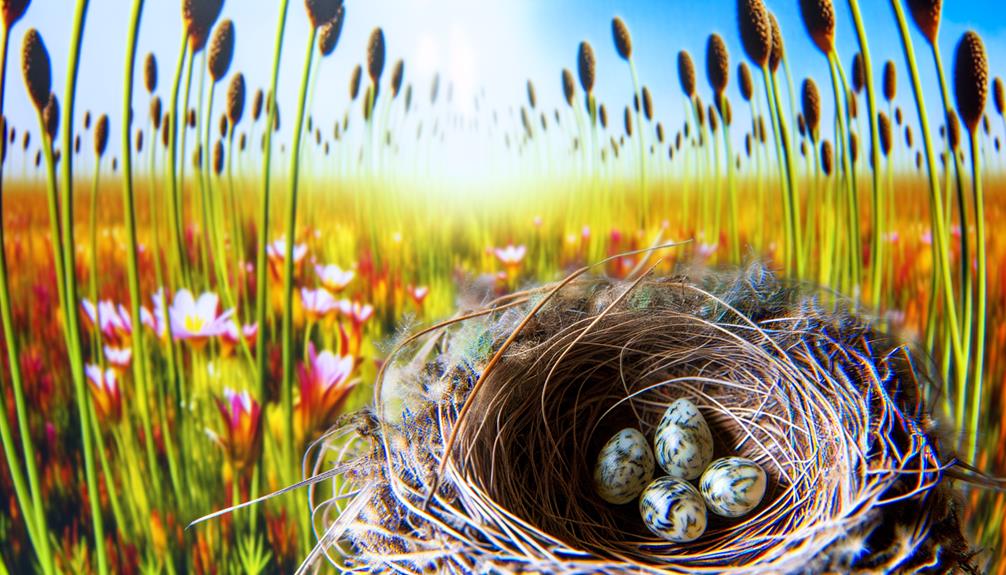
The Cape Sable seaside sparrow plays a critical role in its ecosystem by contributing to the regulation of insect populations and serving as an indicator species for environmental health.
This avian species primarily inhabits the marl prairies of the Florida Everglades, where it preys on a variety of insects, thereby maintaining ecological balance.
The sparrow's presence and reproductive success are closely linked to hydrological conditions, making it a sentinel for wetland health.
Deviations in sparrow populations can signify changes in water levels, vegetation structure, and overall habitat quality.
Therefore, continuous monitoring of this species provides critical data for conservation strategies and adaptive management practices aimed at preserving the intricate dynamics of the Everglades ecosystem.
Conclusion
To sum up, the Cape Sable seaside sparrow displays distinct physical and reproductive traits, including especially small eggs. These features, combined with specific nesting behaviors and a defined breeding period, emphasize the species' ecological specialization.
Despite encountering various predators and dangers, ongoing conservation initiatives seek to alleviate these obstacles. As a result, comprehending the detailed aspects of the Cape Sable seaside sparrow's life history is crucial for successful preservation and underscores its essential role in upholding ecological harmony.

